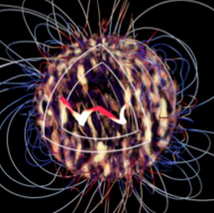The secret of magnetic cycles in stars
 Using new numerical simulations, scientists from the Center for research in astrophysics of Quebec (CRAQ) at University of Montréal, CEA and the Harvard-Smithsonian Center for Astrophysics can explain why the Sun’s magnetic field reverses every eleven years. The discovery of a scaling law determining the magnetic cycle period of a star is pioneering and helps us comprehend violent space weather phenomena. These results are published in the July 14, 2017 issue of Science.
Using new numerical simulations, scientists from the Center for research in astrophysics of Quebec (CRAQ) at University of Montréal, CEA and the Harvard-Smithsonian Center for Astrophysics can explain why the Sun’s magnetic field reverses every eleven years. The discovery of a scaling law determining the magnetic cycle period of a star is pioneering and helps us comprehend violent space weather phenomena. These results are published in the July 14, 2017 issue of Science.
For the past centuries, we have known that the solar magnetic field reversed every 11 years – the south magnetic pole switches to north, and vice versa. This flip occurs during the peak of each solar cycle as the Sun’s inner dynamo restructures itself. For the Sun, we know that magnetic fields originate in the turbulent convective layers and have a complex dependency upon stellar rotation rate. Actually, magnetic cycles are also known for distant stars with fundamental properties as close as possible to the Sun, and studying the characteristics of their surface magnetic activity is a very promising way to understand the solar magnetic evolution associated to dynamo process.
An international collaboration that includes researchers from the CRAQ, CEA (France) and the Harvard Center for Astrophysics carried out a set of 3D simulations of interiors of stars similar to the Sun to explain the origin of their magnetic field cycles. The scientists found that the magnetic cycle period is inversely proportional to the Rossby number, which quantifies the influence of rotation on turbulent convection. The trend relies on a fundamentally non-linear dynamo process and is compatible with the Sun’s cycle and those of other solar-type.
The discovery of a scaling law for the stellar magnetic cycle period using self-consistent turbulent 3D simulations is unprecedented. These offer a new theoretical interpretation of stellar magnetic cycles and put the study of the Sun back at the center of our understanding of stellar astrophysics. By observing more and more stars, and exploring stellar structures different than the Sun’s with numerical simulations, astrophysicists hope to refine this new scenario of the origin of stellar magnetic cycles.
Article:
Reconciling solar and stellar magnetic cycles with nonlinear dynamo simulations. Strugarek A., Beaudoin P., Charbonneau P., Brun A.S., Do Nascimento Jr J.D., Science (2017).
Videos:
https://youtu.be/MdZtYd-Kwco
https://youtu.be/Qf26t4yI6ds
Contact:
Professor Paul Charbonneau
Center for research in astrophysics of Quebec
Université de Montréal
Phone: (514) 343-2300
paulchar@astro.umontreal.ca
Source:
Robert Lamontagne
Public outreach
Center for research in astrophysics of Quebec
Phone: (514) 343-6111 x3195
lamont@astro.umontreal.ca
